Contents
Catching perch in winter can be very exciting and no less productive than angling a striped predator in open water. To achieve a stable bite of this fish during the freezing period, you need to study the features of its behavior well and have well-mounted gear in your arsenal.
Features of perch behavior in winter
The behavior of perch at the beginning, middle and end of the winter season varies significantly. This should certainly be taken into account when going to catch a striped predator.
By first ice
Winter fishing for perch on the first ice is the most productive. This is due to the high oxygen content in the water, which ensures stable feeding activity of the predator.
During the first ice period, the perch behaves quite aggressively and greedily grabs the baits offered to it. If the fish is present at the selected point, bites usually follow in the first minute after the rig is lowered into the hole.
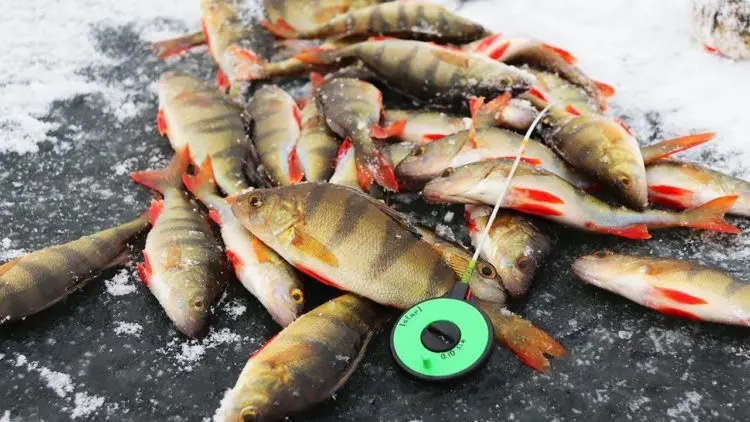
Photo: www.activefisher.net
At the beginning of winter, flocks of perch are more often found at depths of up to 3 m. In such places, the highest concentration of juveniles of cyprinids, which form the basis of the food base of the striped predator, is noted.
In the middle of the season
Closer to the middle of winter, the amount of oxygen dissolved in water decreases sharply, which negatively affects the biting perch. The predator begins to behave extremely passively and treats the baits offered to him with great care.
In the dead of winter, the perch looks at the bait for a long time before attacking it. Fish bites are often very delicate, which requires the use of the most thin and sensitive gear.
In the middle of the winter season, the predator usually feeds at depths of 2–6 m. The search for perch schools at this time is complicated by the thick ice cover.
On the last ice
At the end of winter, perch biting is activated again. This is due to the flow of melted, oxygen-enriched water under the ice.
On the last ice, large perch gather in large flocks and begin to actively move around the water area. During this period, fish are often caught in the middle layers of the water. Sometimes bites occur under the very ice.
The influence of weather on biting
Fishing for perch in winter is most productive on sunny, frosty days. The best biting is noted at elevated atmospheric pressure (745–750 mm Hg). the strength and direction of the wind do not have a special effect on the activity of the predator and only affect the comfort of fishing.
Photo: www. activefisher.net
On cloudy days, when the barometer falls below 740 mm Hg. Art., biting is rarely stable. The only exceptions are long-term thaws, accompanied by drizzling rain, during which intensive snow melting and fresh water flow under the ice are observed.
Where to look for a predator in the winter
Many novice anglers do not know where to look for perch in the winter. When looking for a “striped” one should always take into account the type of reservoir on which fishing takes place.
On big rivers the predator should not be looked for in places with a strong current. In reservoirs of this type, it usually stands:
- in shallow bays;
- on stretches with a slow current;
- in local pits located under steep banks;
- in barred areas.
Sometimes the “striped” can go out to feed closer to the riverbed, but even in this case, he hunts away from the main stream.
On a small river perch in winter can be found in coastal whirlpools 1,5–2 m deep. The predator also likes to stand on the bends of small rivers. Such places are characterized by slow flow and the presence of local pits.

Photo: www.landfish.ru
On lakes and reservoirs perch flocks in winter should be looked for:
- in the coastal zone;
- on the edges of deep-water dumps;
- in local, twisted pits;
- on stretches with a depth of 2–5 m;
- near underwater hills, located at a great distance from the coast.
Perch tries to avoid areas of reservoirs with a heavily silted bottom. Schools of this fish are more often found on sandy, clay or rocky substrates.
Applied tackle and bait
Various types of winter gear are used to fish perch from the ice. With a low activity of the predator, it is important not only to correctly equip the fishing gear, but also to choose the right bait, as well as the way it is fed.
Classic mormyshka
The classic mormyshka, used in combination with an animal bait, is the most versatile lure for ice fishing for striped predators. It works stably for both active and passive fish. When fishing perch, the following models have proven themselves better:
- «crumb»;
- “droplet”;
- “disco layer”.
On the first ice, when the fish shows increased activity, lead mormyshkas with a diameter of 3,5–4 mm can be used. Well, if they will have a copper coating.
With a sluggish bite in the middle of winter, you need to use small mormyshki with a diameter of 2,5-3 mm, made of tungsten. Such baits, with a large weight, have the smallest size, which is very important when it comes to fishing passive fish.
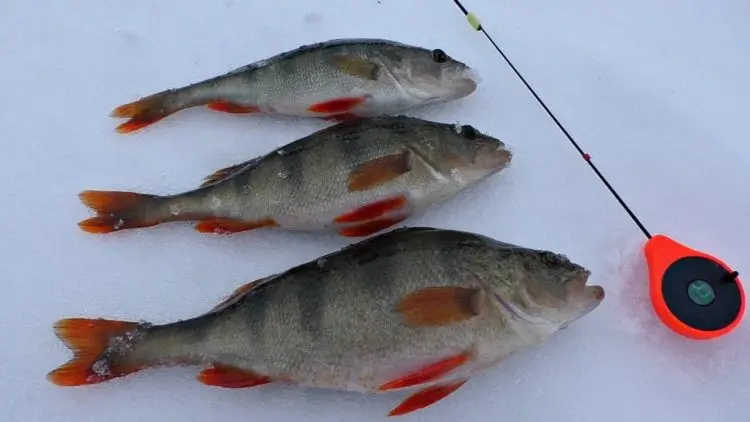
Photo: www. ytimg.com
Mormyshka should be equipped with a thin but strong hook. This will minimize the trauma of the bait during hooking and allow the bait to move actively during the fishing process, better attracting the attention of the predator.
For effective fishing of the “striped” mormyshka, you will need winter tackle, which includes:
- winter fishing rod of the “balalaika” type;
- short nod 4–6 cm long;
- monofilament fishing line with a thickness of 0,07–0,12 mm.
For fishing on a mormyshka, a balalaika-type fishing rod equipped with a coil built into the body is better suited. It fits well in the hand and allows you to quickly change the fishing horizon, which is very important when it comes to an active search for fish, which involves frequent changes of places.
The nod used in the equipment is usually made of lavsan or plastic materials. This element should have a length of no more than 6 cm, which will allow you to make a small-amplitude game with a jig and make a more reliable hook. On the whip of the fishing rod, the nod is attached with a silicone cambric.
When fishing “striped” on the first and last ice, the fishing rod can be equipped with a monofilament line with a diameter of 0,1-0,12 mm. In the middle of winter, thinner monofilaments with a thickness of 0,07–0,09 mm should be used.
Before catching a perch on a mormyshka, the angler will need to master the correct supply of this bait. In the vast majority of cases, this fish responds better to the following animation:
- Mormyshka is slowly lowered to the bottom;
- Make 2-3 hits with the bait on the ground, thereby raising a cloud of turbidity;
- Slowly raise the mormyshka from the bottom to a height of 30–50 cm, while giving a nod to fast, small-amplitude movements;
- The cycle with lowering the bait to the bottom and slowly lifting it is repeated several times.
In the dead of winter, perch sometimes responds better to a mormyshka lying motionless on the ground. This method of feeding the bait often works in closed reservoirs.
“Remote”
The mormyshka “mothless” also works great for ice fishing for a striped predator. Natural baits are not planted on her hook. As artificial attracting elements use:
- small metal chains 1–1,5 cm long;
- multi-colored beads;
- woolen threads;
- various silicone and plastic elements.
When angling perch, the following models of “remoteless” have proven themselves well:
- “iron ball”;
- “goat”;
- “Cat’s eye”;
- “crap”;
- “nymph”.
For fishing on a “remoteless” use the same tackle as when fishing on a classic mormyshka. The only difference is the length of the nod, which is usually 10-15 cm – this allows you to give the bait a more complex and varied game.
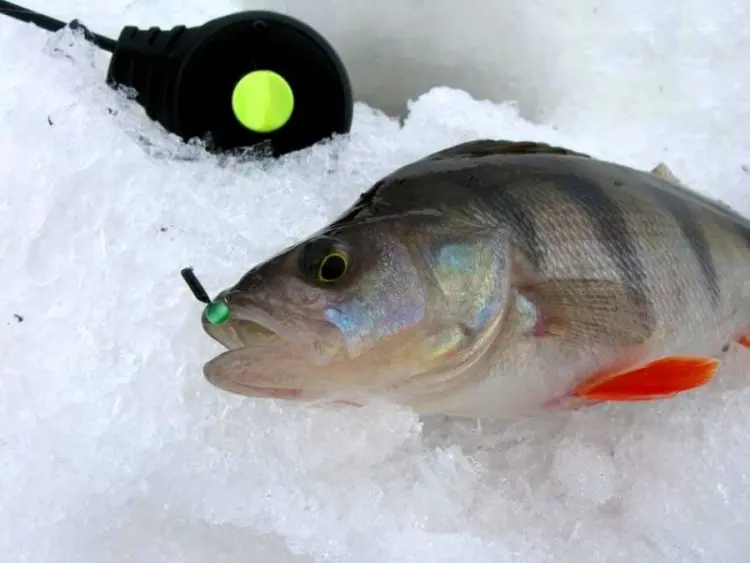
Photo: www.avatars.mds.yandex.net
The method of animation of the “mothless” is determined empirically and depends on the activity and nature of the perch’s diet at the time of fishing. Playing with bait can be both fast, small-amplitude movements with a smooth rise from the bottom to the middle layers of the water, and smooth, sweeping oscillations. Ideally, this artificial bait, when served, should resemble the natural behavior of food objects familiar to fish.
Vertical spinner
The vertical lure is one of the best artificial lures for ice fishing perch. When catching this predator, small models 3–7 cm long are used, equipped with a single soldered hook or a hanging “tee”.
Silver baubles are considered the most versatile. On some reservoirs, copper or brass lures work better.
Triple or single hook vertical spinners are often equipped with bright cambrics. This increases the attractiveness of the bait and leads to more successful bites.
To fish a perch from ice to a lure, tackle is used, consisting of the following elements:
- a light fishing rod of the “filly” type with a hard whip equipped with throughput rings;
- fluorocarbon fishing line 0,12–0,15 mm thick, oriented to fishing at low temperatures;
- a small carabiner (when fishing on large spinners).
A light winter fishing rod for perch of the “filly” type, equipped with a hard whip, has increased sensitivity, allowing you to feel the bait well and feel the slightest touch of the predator on the lure.
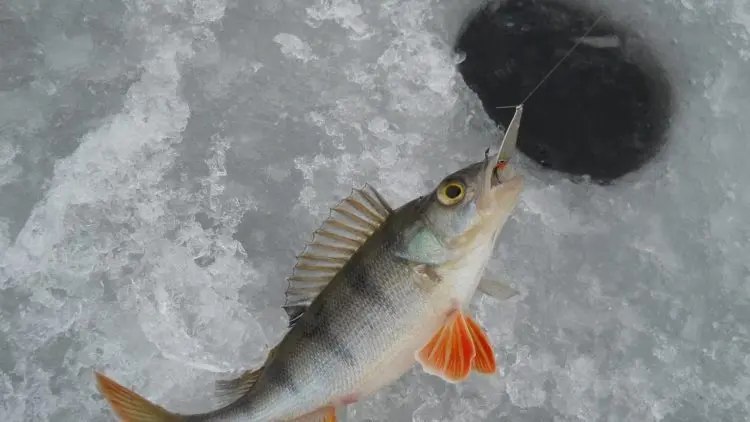
Photo: www.activefisher.net
Many winter anglers equip the lure rod with a short nod – this should not be done. This part disrupts the operation of the lure during wiring and reduces the sensitivity of the gear.
A fishing rod for winter lure is best equipped with fluorocarbon monofilament. It has several advantages over monofilament line:
- completely invisible in the water;
- has a long service life;
- well transfers the abrasive loadings arising at contact with sharp edges of ice.
When fishing “striped” small and medium size, “fluorocarbon” with a thickness of 0,12 is used. When it comes to catching large perch, a fishing line with a diameter of 0,14-0,15 mm is used.
When fishing with large spinners about 7 cm long, a carabiner is included in the equipment, which allows you to quickly change the bait. When small lures 3-5 cm in size are used, the clasp is not used, since it disrupts the play of a light bait.
The feed of the vertical spinner is carried out according to the following scheme:
- I lower the spinner to the bottom;
- Make 3-4 hits with the bait on the ground;
- Raise the lure 3–5 cm from the bottom;
- They make a sharp toss of the bait with an amplitude of 10–20 cm (depending on the size of the spinner);
- Quickly return the tip of the rod to the starting point;
- Make a few more tosses in this horizon;
- Raise the lure 4–5 cm higher;
- Continue the cycle with tossing and lifting the bait.
If fishing is carried out in shallow water, as a rule, bottom layers of water are caught. When fishing at a depth of more than 2 m, the lure is presented in all horizons.
Balance
Throughout the winter, the “striped” is successfully caught on balancers. This artificial bait belongs to the class of horizontal spinners. It has a wide game and perfectly lures a predator from a long distance.
To catch small and medium fish, balancers 3–5 cm long are used. Humpback perch, whose weight often exceeds a kilogram mark, responds better to lures 6–9 cm in size.
With increased feeding activity of the predator, balancers of bright (acidic) colors work better. When the fish is passive, the most stable results are shown by natural color lures.
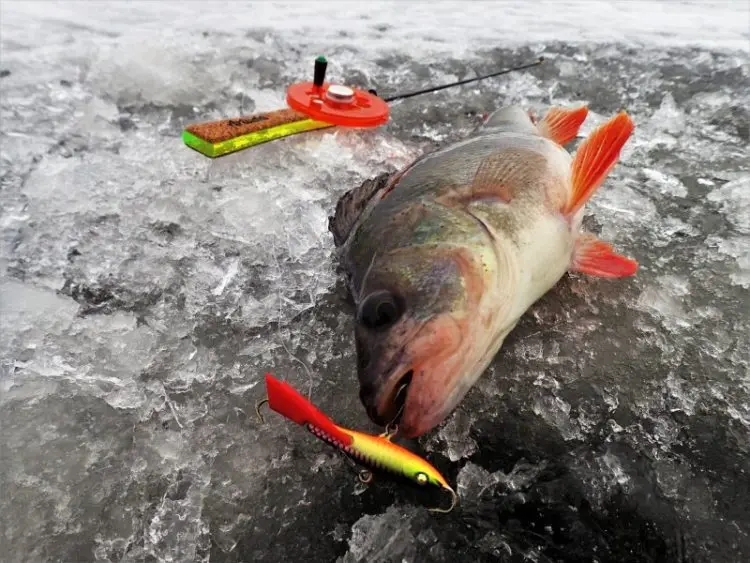
Photo: www.fishingsib.ru
When fishing on balancers, they use the same tackle as for vertical spinners. It allows you to easily control the bait and transmits the most careful bites well.
When fishing on a balancer, the lure game looks like this:
- The balancer is lowered to the bottom;
- Make several hits with the bait on the ground;
- Raise the balancer by 3–5 cm from the bottom;
- Make a sharp swing (not toss) with a fishing rod with an amplitude of 10–20 cm;
- Quickly the tip of the rod to the starting point;
- Make 2-3 more sharp strokes in this horizon;
- Raise the balancer 5–7 cm higher;
- The cycle is repeated with swings and lifts of the bait, catching all layers of water.
When fishing on a balancer, it is important to choose the right swing speed. If you make a jerk too fast, the lure will abruptly go to the side, which can frighten a nearby predator. With a very slow swing, the balancer will not play properly and is unlikely to attract fish.
Balancers are usually equipped with one “tee” and two single hooks, which is why they are not recommended for use in thick snags. If this rule is not observed, you can lose the entire set of lures in one fishing trip.
“Balda”
The bait called “balda” is a metal element in the form of an elongated drop and a through, transverse hole in the upper part. Depending on the depth at the place of fishing, the weight of this part can vary from 2 to 6 g.
In the equipment of the “bastard” there are also 2 hooks No. 8–4, with cambrics or beads put on them. They move freely during wiring, imitating the limbs of an aquatic insect.
In order for the “balda” to arouse interest in the fish, it must be properly mounted. The assembly process of the bait is divided into several stages:
- A hook is strung on a fishing line;
- A metal element is put on the monofilament;
- A second hook is put on the fishing line;
- All elements are shifted together;
- The end of the fishing line is applied to the main monofilament;
- A “blind” loop with a diameter of 3–5 cm is formed.
When assembling the bait, it is important to take into account that the stings of the hooks must be directed in the opposite direction from the metal load.
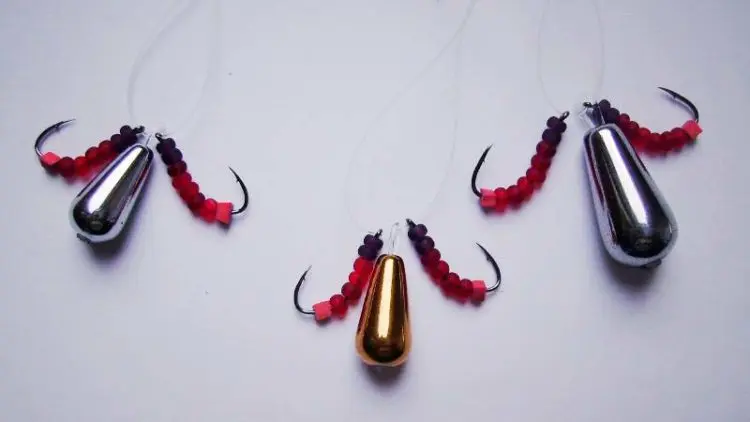
Photo: www.manrule.ru
In combination with the “bastard” they use the same tackle as when fishing with vertical spinners. The game of bait is carried out according to the following scheme:
- “Baldoo” is lowered to the bottom;
- Make several hits with the bait on the ground;
- Slowly raise the bait 5-10 cm from the bottom, while gently shaking the tip of the fishing rod;
- The cycle with tapping on the bottom and lifting is repeated.
“Balda” works well when perch feeds in the bottom layers. If the fish hunts in the middle horizon, this bait is ineffective.
Rattlin (choice)
Trophy perch in the winter months are well caught on rattlins. This bait creates strong vibrations during wiring, attracting a predator from afar.
To catch perch, rattlins 5-10 cm long are usually used. In most cases, the fish responds better to vibes of natural colors.
When fishing on rattlins, tackle is used, equipped with:
- a winter fishing rod equipped with a reel seat and a long, elastic whip with throughput rings;
- a small inertial or inertial coil;
- fluorocarbon fishing line 0,14–0,18 mm thick;
- carabiner for quick change of bait.
A winter fishing rod equipped with an elastic whip, a reel and a fairly thick fishing line allows you to quickly lower the bait to the required depth and confidently pull out a perch weighing more than a kilogram.
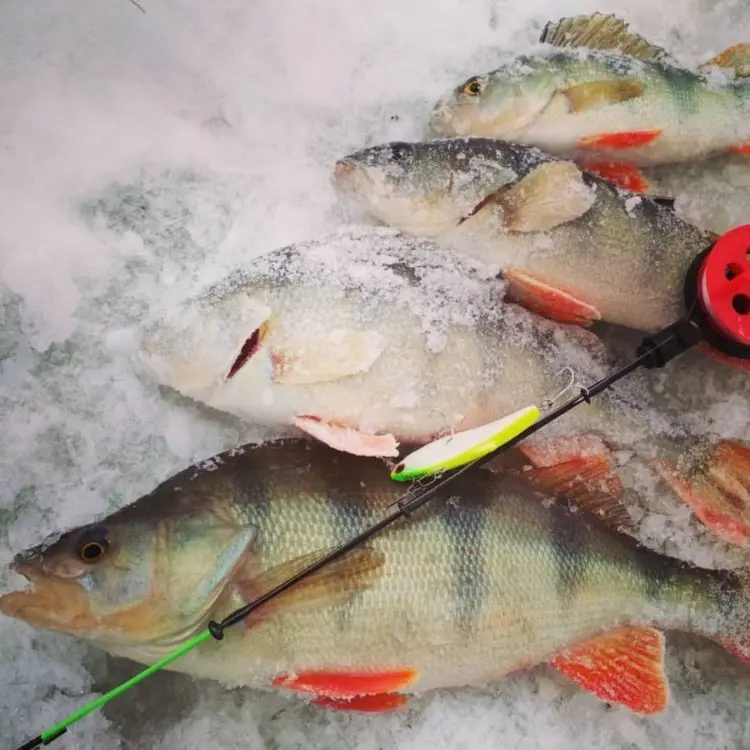
Photo: www.i.siteapi.org
Vib animation is performed according to the following scheme:
- The bait is lowered to the bottom;
- Rattlin is raised 5–10 cm from the bottom;
- Make a smooth swing with a fishing rod with an amplitude of 15–25 cm;
- Return the tip of the fishing rod to the starting point;
- Waiting for the bait to come to rest;
- Make another 3-4 strokes in this horizon;
- Raise the rattlin by 10–15 cm;
- Repeat the cycle with smooth strokes, catching all horizons.
When the striped predator is passive, you can diversify the game of the lure by slowly lifting the rattlin from the bottom and making smooth swings with an amplitude of 3–5 cm.
The wide play of the rattlin and the presence of several hooks in its equipment limit the scope of this lure. It is better not to use vibes in thick snags.
natural baits
In order to successfully catch perch during the freezing period, you need to know what this fish bites on in winter. The mormyshka hook is better to bait:
- bloodworm;
- maidservant;
- fry;
- burdock moth larva;
- fragments of a dung worm.
Bloodworm – the most common attachment for ice fishing perch. With a sluggish biting, the hook is baited with one large larva. When the fish is active, plant 2-3 large bloodworms.
Oparysh also effective in angling striped. 1-2 large larvae are usually planted on the hook. Perch are more likely to respond to maggots, painted in light green, orange or pink.
Malok carp species of fish – an excellent bait for ice fishing “striped”. As a nozzle, they usually use crucian carp, roach or bleak 4–6 cm long. A small fish is planted, passing the hook into one of its nostrils.
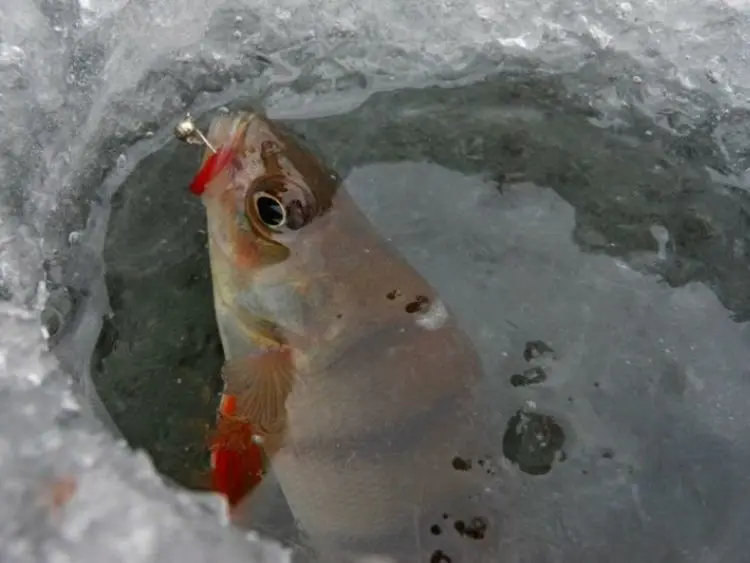
Photo: www. avatars.mds.yandex.net
Burdock moth larva has a special aroma that perch really likes. It can be used as an independent bait, and as a replant to a worm or bloodworm.
The jigsaw hook can also be baited with 1-2 cm long dung worm fragments. This bait works especially well when catching large perch.
Lure
In winter, a flock of perches can be collected under the hole with the help of bait. As a bait use:
- feed bloodworm;
- dry beef blood;
- small maggot;
- red trout bait;
- cut worm.
If fishing is carried out in shallow water, bait components can be thrown directly into the hole. When fishing in places with a depth of more than 2 m, the bait is delivered to the bottom using a small feeder with a volume of 50-100 ml.
Catching strategy
Beginning anglers often do not know how to catch a large number of perches in a short winter day. Catching a striped predator from the ice involves a constant search for fish and frequent changes of places. If within 3-5 minutes. there was no bite, you need to go to another hole.
When fishing perch in shallow water, you need to catch the bottom layers of water. In the absence of bites, a new hole should be drilled at a distance of 5–7 m from the previous one.
When fishing is carried out in areas with a depth of more than 2 m, it is necessary to fish not only the bottom, but also the middle and upper horizons. In the absence of bites, a new hole is drilled at a distance of 10–15 m from the previous one.









